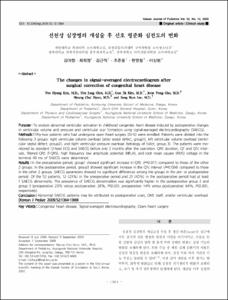선천성 심장병의 개심술 후 신호 평준화 심전도의 변화
- Keimyung Author(s)
- Kim, Yeo Hyang
- Department
- Dept. of Pediatrics (소아청소년학)
- Journal Title
- Korean Journal of Pediatrics
- Issued Date
- 2009
- Volume
- 52
- Issue
- 12
- Abstract
- Purpose : To analyze abnormal ventricular activation in childhood congenital heart disease induced by postoperative changes in ventricular volume and pressure and ventricular scar formation using signal-averaged electrocardiography (SAECG). Methods : Fifty-two patients who had undergone open heart surgery (OHS) were enrolled. Patients were divided into the following 3 groups: right ventricular volume overload (atrial septal defect, group1), left ventricular volume overload (ventricular septal defect, group2), and right ventricular pressure overload (tetralogy of Fallot, group 3). The patients were monitored by standard 12-lead ECG and SAECG before and 2 months after the operation. QRS duration, QT and QTc intervals, filtered QRS (f-QRS), high frequency low amplitude potential (HFLA), and root mean square (RMS) voltage in the terminal 40 ms of SAECG were determined. Results : In the preoperative period, group1 showed significant increase in QRS (P=0.011) compared to those of the other 2 groups. In the postoperative period, group3 showed significant increase in the QTc interval (P=0.004) compared to those in the other 2 groups. SAECG parameters showed no significant differences among the groups in the pre- or postoperative period. Of the 52 patients, 12 (23%) in the preoperative period and 21 (40%) in the postoperative period had at least 1 SAECG abnormality. The prevalence of SAECG abnormalities was significantly higher in the postoperative group 2 and group 3 (preoperative: 20% versus postoperative: 28%, P<0.001, preoperative: 14% versus postoperative: 64%, P<0.001, respectively). Conclusion : Abnormal SAECG patterns may be attributed to postoperative scars, OHS itself, and/or ventricular overload.
목 적 : 이번 연구에서는 소아기에 흔한 선천성 심장병 환자들을 대상으로 개심술 이후 생긴 반흔과 수술로 인한 용적 또는 압력 과부하 상태의 변화로 초래되는 비정상적인 심실 활성화를 신호 평준화 심전도를 이용하여 분석하고자 하였다. 방 법 : 선천성 심장병으로 개심교정술을 시행한 환자 52명을 대상으로 하였다. 환자군은 우심실 용적 과부하군(심방 중격 결손군, 1군), 좌심실 용적 과부하군(심실 중격 결손군, 2군), 우심실 압력 과부하군(활로씨 4징군, 3군)으로 나누었다. 대상 환자 모두에서 표준 12 유도 심전도와 신호 평준화 심전도 검사를 시행하였고, 평균 QRS 기간, QT와 QTc 간격, f-QRS, HFLA, RMS in terminal 40 ms를 구하였다. 결 과 : 수술 전에는 1군에서 다른 군에 비해 의미 있게 긴 QRS 기간을 보였고(P=0.011), 수술 후에는 3 군에서 다른 군에 비해 QTc 간격이 의미 있는 증가가 있었다(P=0.004). 그러나 신호 평준화 심전도는 수술 전후 환자군 간에 차이가 없었다. 전체 대상 환자 중 신호 평준화 심전도 측정값이 한가지 이상 후 전위의 진단 기준에 해당되는 경우가 수술 전 12명(23%)에서 수술 후 21명(40%)로 증가하였다. 특히 2군과 3군에서는 수술 전에 비해 수술 후에 신호 평준화 심전도의 이상 소견을 보이는 경우가 의미있게 많았다(2군: 20% versus 28%, P<0.001, 3군: 14% versus 64%, P<0.001). 결 론 : 비정상적인 신호 평준화 심전도 값은 수술 후 반흔뿐만 아니라 개심술 자체, 심실의 과부하에 의해서도 발생할 수 있다.
- Alternative Title
- The changes in signal-averaged electrocardiogram after surgical correction of congenital heart disease
- Keimyung Author(s)(Kor)
- 김여향
- Publisher
- School of Medicine
- Citation
- 김여향 et al. (2009). 선천성 심장병의 개심술 후 신호 평준화 심전도의 변화. Korean Journal of Pediatrics, 52(12), 1364–1369. doi: 10.3345/kjp.2009.52.12.1364
- Type
- Article
- ISSN
- 1738-1061
- Appears in Collections:
- 1. School of Medicine (의과대학) > Dept. of Pediatrics (소아청소년학)
- 파일 목록
-
-
Download
 oak-aaa-03526.pdf
기타 데이터 / 447.26 kB / Adobe PDF
oak-aaa-03526.pdf
기타 데이터 / 447.26 kB / Adobe PDF
-
Items in Repository are protected by copyright, with all rights reserved, unless otherwise indicated.